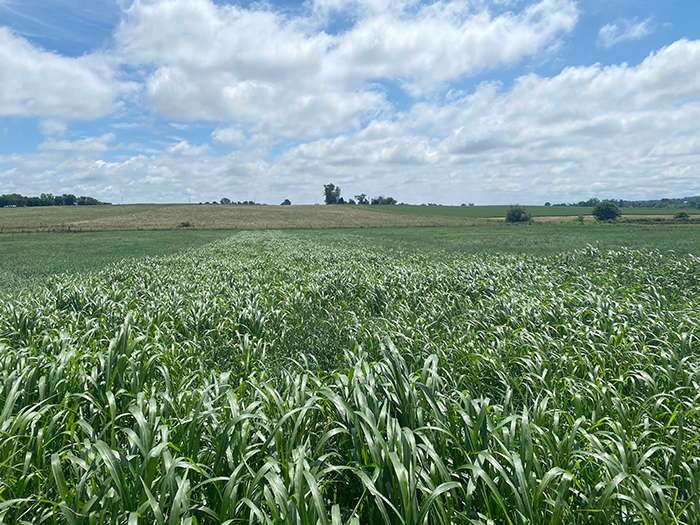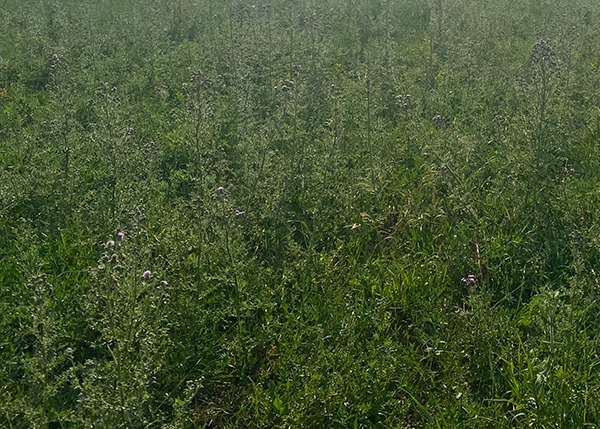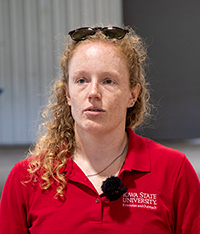Interseeding sudangrass into abused pastures |
| By Mike Rankin, Senior Editor |
|
|
 Photo: Iowa State University Trying to get additional forage production from sacrifice pastures used for overwintering or spring calving is a struggle on many farms. Often, these sacrifice paddocks can be beat up, overgrazed, and have large areas of exposed soil. There’s a laundry list of strategies on how to deal with these damaged pastures. One option is to simply wait and leave the heavy lifting to Mother Nature. Of course, this takes time and there is usually a plethora of annual and perennial weeds that can establish along with more desirable grasses and legumes. Reseeding the area is another option. This can be done with a mix of ryegrass and other desirable perennial forage species. Seeding a summer annual into the damaged forage stand is another approach, and it’s one being investigated by extension specialists at Iowa State University. Last week, they had a field day at Kirkwood Community College in Cedar Rapids to highlight their results to date. At three Iowa locations, Piper sudangrass was seeded into existing grass pastures that had been used as a spring calving or overwintering paddocks. The sudangrass was seeded at 15 or 30 pounds per acre during the first week of June in 2023 and 2024 while also leaving an unseeded control plot. They plan to repeat the practice again in 2025, so stay tuned for the final results. The sudangrass-seeded and unseeded plots were grazed at the same time once the annual forage reached an adequate height. The thought process was that the sudangrass not only would provide additional forage, but it would be available at a time when most cool-season grasses were in their summer slump period. In 2023 — the first year of the trial — rainfall was at a premium after seeding and Canada thistle became a huge problem at the Cedar Rapids site. Both seed germination and forage yield suffered. This year, abundant rains fell and there was good establishment of the sudangrass. Beth Reynolds, an extension beef program specialist, said their observations to date have included that cattle preferentially graze the sudangrass before the existing perennial grass pasture. “The animals go straight to the sudangrass plots even when there is adequate cool-season forage in other plots.”  Cattle preferentially grazed the sudangrass, which is now developing new tillers. The researchers have been measuring yield variables, including what impact the growing sudangrass will have on the following year’s perennial pasture growth. It’s still too early to draw any firm conclusions. Water and weeds The dry conditions in 2023 posed a myriad of problems at the Cedar Rapids location. Although rain was forecasted for the day after seeding, it never came. This severely hindered germination and sudangrass growth. A Canada thistle infestation also offered significant competition to the desirable forage species. In the plots without sudangrass, thistles were sprayed twice with 2,4-D — once in spring and again in the fall. The thistles in the sudangrass plots were mowed with a rotary mower in the spring before seeding, then sprayed in the fall. Much of the area was devoid of Canada thistle in 2024.  Canada thistle can become a big problem when given the opportunity to spread. This is what happened in the 2023 sudangrass plots. Photo: Iowa State University “Weeds are great opportunists that often follow our crop cycles,” said Shelby Gruss, the extension forage specialist with Iowa State University. “Unlike row-crop fields, pastures offer the opportunity for perennial weeds to establish and thrive if left uncontrolled. The first step in a successful weed control program is knowing what weeds are causing a problem and identifying their life cycles.” Perennial weeds, such as Canada thistle, are often the most difficult to control. “Think of what you have to do to maintain alfalfa persistence, then do the opposite for perennial weeds,” Gruss asserted. “For many of these weed species, you can weaken or kill them by applying controls when plants are in the late vegetative or early bud stages. This is when the root reserves for regrowth are at their lowest point. It’s also most effective when controls are imposed in the fall,” she added. Cultural, mechanical, and chemical control methods are all effective but often need to be used with an integrated mindset.  Shelby Gruss Cultural control of pasture weeds hinges on having a thick, healthy forage stand. This is accomplished by not overgrazing and giving pastures time to recover after being grazed. Gruss also mentioned the use of goats as an effective cultural method to eliminate problem weeds that other livestock species won’t consume. Beyond cultural practices, there are also mechanical methods such as mowing, which Gruss suggested is not a “one and done” practice. Mowing weeds is generally only effective for perennials when it’s done multiple times for multiple years. For annual and biennial weeds, mowing can eliminate seed production if done before the plants produce viable seeds. Herbicides make up the third leg of the pasture weed control stool. Gruss cautioned that repeatedly using the same herbicide mode of action can sometimes lead to weed resistance. For this reason, she emphasized the importance of an integrated weed control approach that incorporates more than one weed control strategy and more than one herbicide site of action. |
